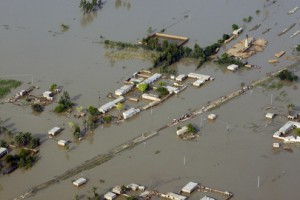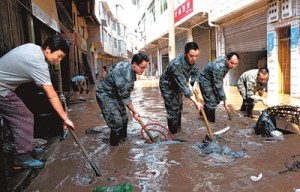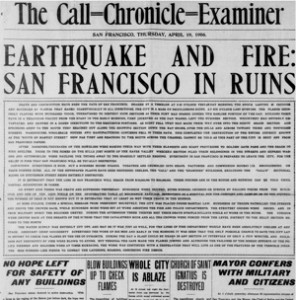A whistle blower lawsuit filed against the Allstate Insurance Company alleges that the company inflated the amount of flood losses sustained by three clients in connection with Katrina-related homeowners’ insurance claims that Allstate had disputed. The whistle blower is an attorney who represented the homeowners and reports direct knowledge of the allegations, asserting that Allstate fabricated insurance documents to shift its own claims obligations to the federal government. Flood losses are not covered by a standard homeowners policy, but instead are covered when the government’s National Flood Insurance Program provides insurance. Although the whistle blower lawsuit was filed more than three years ago, Allstate was just informed of the matter last week. The whistle blower filed the suit of the government for which he seeks three times the amount of fraud losses plus civil fines and legal expenses. The case will be heard in New Orleans. While the facts of the case have yet to be determined by the court, it is clear that the existence of a government-funded program provides incentives for cost-shifting at taxpayer expense.
Archive for the ‘Floods’ Category
Whistleblower Alleges Katrina Insurance Fraud
Sunday, October 3rd, 2010NFIP Extension is a Stop-Gap Measure
Friday, October 1st, 2010Late in the day yesterday President Obama authorized an extension of the National Flood Insurance Program until September 30. This reprieve comes as welcome news to NFIP’s more than five million policyholders, as NFIP has lapsed three times this year. The extension also offers another measure of stability to the real estate market. “Today’s signing will come as a relief for millions of Americans who could be affected by floods or just wish to buy or sell a home,” said Jimi Grande, senior vice president of federal and political affairs for National Association of Mutual Insurance Companies. But for small businesses that own or lease commercial properties in flood zones, the uncertainty continues. The NFIP is $18 billion in debt and no measures have been taken to assure its long-term solvency. Long-overdue reforms, such as the inclusion of wind coverage and optional business interruption insurance remain unresolved. We need to keep the pressure on our elected representatives for a long-term solution for sustainable insurance cover.
Tropical Storm Nicole Wreaks Havoc
Thursday, September 30th, 2010Tropical Storm Nicole’s remnants are wreaking havoc on the East Coast. Right now I am listening to the sounds of 45 mph winds outside my home as rain beats down on the windows. According to the meteorologists, this is just the beginning. Tens of millions of people reside in the projected path of the storm. Flash flood warnings have been issued for every state from the Carolinas to Maine. Indeed, Nicole’s rain and winds have already exceeded the record set by Hurricane Floyd in Wilmington, North Carolina, where the city has received nearly two feet of rain this week. Floods are actually very common hazards, but as 30% of the communities that flood in any given year have never before flooded, residents are often unprepared.
Flood warnings are of particular concern in this economy. The states’ budget deficits have resulted in underfunded disaster mitigation and relief programs. And households and businesses often cut their insurance protection to save premium expenses. I remember the news reports of families in Rhode Island that had terminated their homeowners and other insurance when their mortgages were paid. Apparently they had only purchased insurance to comply with their banks’ lending requirements. Sadly when the epic floods struck Rhode Island this spring, they had no protection. Those of us in the East Coast should make appropriate plans. I have done all of my grocery shopping and errands and plan to work from home for the next few days.
This interactive graphic shows the projected path of Tropical Storm Nicole and various deviations as the impacts of the storm move across the northward trajectory. As you can see, it is not just the direct coastal areas that are affected as the rain and winds will move inland.
Pakistan Submerged
Sunday, September 5th, 2010Since the monsoon rain season began last month, floodwaters have devastated Pakistan. The floods have displaced more than 20 million Pakistanis, a number that exceeds the entire population of New York State. One fifth of Pakistan’s land mass is submerged, as shown in this photograph provided by the United Nations. Many communities are isolated as traditional transport routes are no longer viable. It is truly a humanitarian crisis with urgent needs for water, food, shelter and sanitation. Public health officials fear the spread of water-borne diseases, such as cholera. For more information about Pakistan’s pressing needs, please click unicef-immediate-needs-document-pakistan-flooding-26-august-2010 to download a current report from the U.S. Committee for UNICEF. To make a contribution to UNICEF for Pakistani flood relief, clear here for a direct link where you can donate online.
I also want to introduce you to Kashf Foundation, an organization that provides sustainable financial services to poor women in Pakistan, allowing them to become economically self-sufficient. I had the privilege to meet Roshaneh Zafar, Kashf’s founder, when she served on the UN Advisors Group for Inclusive Financial Sectors. Click here to learn more about Kashf and how you can support their important work.
Massive Floods World Wide
Tuesday, August 24th, 2010This appears to be the year for epic flooding. Rhode Island experienced the worst flooding in 200 years in the spring and many affected businesses have yet to re-open. Tennessee experienced a 1-in-500 year flood event, devastating a good part of the state, including Nashville and the Grand Ole Opry. Germany, the Czech Republic and Poland experienced major floods this year. China’s floods required massive mobilization of public resources. India is underwater and Pakistan’s flooding represents a humanitarian crisis with the very real threat of cholera and other water-borne illnesses. Check out the photographs of the flooding disasters from Asia to Europe here. The tragedies are compounded by the fact the lack of public resources to provide relief aid, as a consequence of a protracted global recession. We should all give whatever we can.
Severe Floods in China
Wednesday, July 21st, 2010More than 700 people died and 347 more are missing following torrential rains and floods in China, the worst that country has experienced in a decade. The floods affected 110 million people in 27 provinces and municipalities; 8 million residents of those areas were evacuated. The Chinese government estimates direct economic losses from the flood to be $21 billion, which includes damages to more than 7 million agricultural hectares and the destruction of more than 600,000 homes. The government also reported that 287,000 military personnel had aided in the flood rescue operations. This year’s flood season, which begins in China in April, has been unusually severe. In more than 230 rivers across the country, water levels have risen above what is considered safe. Areas adjacent to the Yangtze River have experienced the worst flooding in 30 years but, according to the Chinese government, the Three Gorges Dam prevented even more severe flood damage by blocking more than 40% of the water.
I have not yet formed an opinion on whether global warming has induced permanent climate change. But it is undeniable that we are experiencing the most severe weather patterns in some time and it appears to be a global phenomenon. At a time when the recession has stretched resources thin, we are particularly vulnerable to external shocks, such as natural disasters. And public resources are inadequate to fund relief efforts. Many people will try to ease the pressure on their budgets by foregoing “non-essentials”, such as insurance, when times are tough. But that is when you need it the most. Sadly, for entrepreneurs in China, most small businesses don’t have access to adequate insurance coverage. We do, so there is no excuse for us.
Flooding in the Rio Grande
Sunday, July 11th, 2010In 2007, I had the great experience of visiting Laredo, Texas, a community on the Mexican border, for the purpose of delivering disaster preparedness workshops with the San Antonio Small Business Development Centers. Over the past several days, Laredo has experienced extreme flooding as the water levels of the Rio Grande River rose to 42 feet. As of today, the levels are back down to 30 feet, as residents await a decision as to whether disaster aid will be made available to their community. Sadly, many of the affected residents were without flood insurance that costs, on average, $1500 annually in that community. It is particularly difficult in this recession for small businesses and families to budget for expensive insurance coverage until they learn the costs of being uninsured. I will post alerts to this blog as soon as private fundraising initiatives are announced for those who wish to contribute. Laredo is not a wealthy community and needs our support.
A Disastrous Weekend
Sunday, June 20th, 2010The weekend began with a series of giant tornadoes tearing through Minnesota, destroying buildings and causing at least three deaths. The National Weather Service received 36 reports of tornado sightings which, if all are confirmed, would exceed the previous record of 27 tornadoes striking Minnesota in a single day, back in 1992.
Estimates of the volume of oil leaking each day into the Gulf of Mexico were revised upward as more information about the extent of the rig damage came to light. More Gulf Coast tourism and fishing businesses closed as a consequence of the environmental damage. USA Today published an excellent article about the disaster fatigue suffered by Gulf Coast residents who are “forever in recovery” as Katrina-inflicted damage is still with them even as they face the consequences of the oil spill.
The southern states experienced an extreme heat wave, with temperatures in the high 90s/100s. And summer doesn’t officially begin until tomorrow! We are in for a tough weather season. To get you thinking about updating your disaster recovery plan, check out the following article by Inc. magazine columnist Donna Fenn.
Severe Flooding in Eastern and Central Europe
Saturday, May 22nd, 2010Heavy rainfall over a period of days ruptured river bank dykes and triggered flash flooding in low lying areas of Poland, Hungary, the Czech Republic and the Slovak Republic. Strong winds accompanied the heavy rain, causing power outages and disrupting transportation. At least twelve people have been killed with thousands of homes and businesses flooded. Southern Poland was hit the hardest; experiencing the worst floods in ten years after the Vistula River burst a dyke. Government officials in Poland estimate the flood damage to be in excess of €2 billion or US$2.5 billion. Following on the worst floods in 200 years in Rhode Island and the worst floods in 500 years in Tennessee, the weather patterns of extreme frequency and severity are alarming. Make certain your flood insurance is up to date. In any given year, 30% of the properties that flood are located in regions that have never before flooded or are not located in identified flood plains. In other words, you can’t necessarily assume that your property is not at risk for its location.
Banking on Tennessee
Wednesday, May 12th, 2010On page 140 of Prepare for the Worst, Plan for the Best: Disaster Preparedness and Recovery for Small Businesses (Wiley, second edition paperback, 2009), I informed readers that when the President declares a federal disaster, early withdrawal penalties on time deposits are waived as residents and businesses will need additional cash resources to recover. Many banks are unaware of this requirement, so I recommended that if your bank is not, get the cash as soon as you need it and seek reimbursement of any early withdrawal penalties, time permitting, when you are further along in your recovery efforts. I also recommended that you immediately request forbearance on any and all loans and credit facilities. In disaster recovery mode, you will need every inch of breathing room you can get.
So I was delighted to read that Bank of America is putting into effect a disaster relief program in the 42 Tennessee counties designated federal disaster areas by the Federal Emergency Management Agency. The Bank’s disaster relief program provides that small businesses in the affected counties may qualify to avoid early withdrawal penalties on bank certificates of deposit. They may also receive emergency credit line increases on their bank credit cards and may modify or extend payments on loans, credit cards or lines of credit. This is exactly the way to proactively help small business customers in the aftermath of a disaster.
And may I make an additional suggestion to the Bank of America? In the aftermath of a disaster, many small businesses with otherwise pristine credit histories will develop blemishes on their credit reports though no fault of their own. The business will inevitably have some customers that were unprepared for the disaster and will be delayed or default entirely on their obligations, causing some strain on the business. This is the time for banks to show some flexibility and take these factors into consideration for loan applicants.
At a time when bashing banks has become politically fashionable, we should remember how they support our communities. In banking on Tennessee, Bank of America is being true to its roots. A.P. Giannini, the founder of Bank of Italy, the institution that is the predecessor to the Bank of America, saw the opportunity represented by the devastating San Francisco earthquake of 1906. As other banks succumbed to panic, his made emergency loans to customers, mostly immigrant owned businesses, earning the bank their loyalty. This cemented the Bank’s position as a leading financier to the film and wine industries in northern California.




